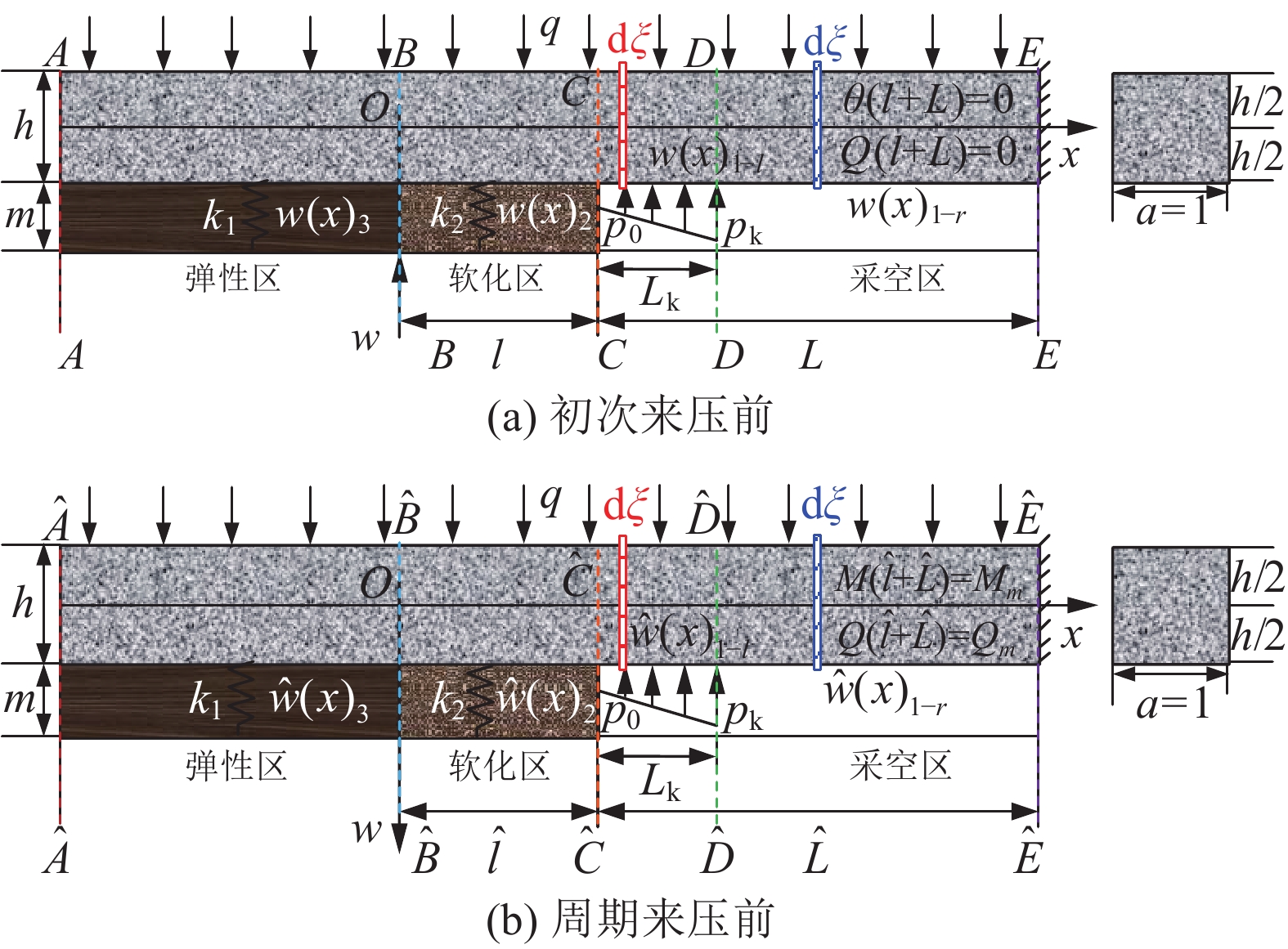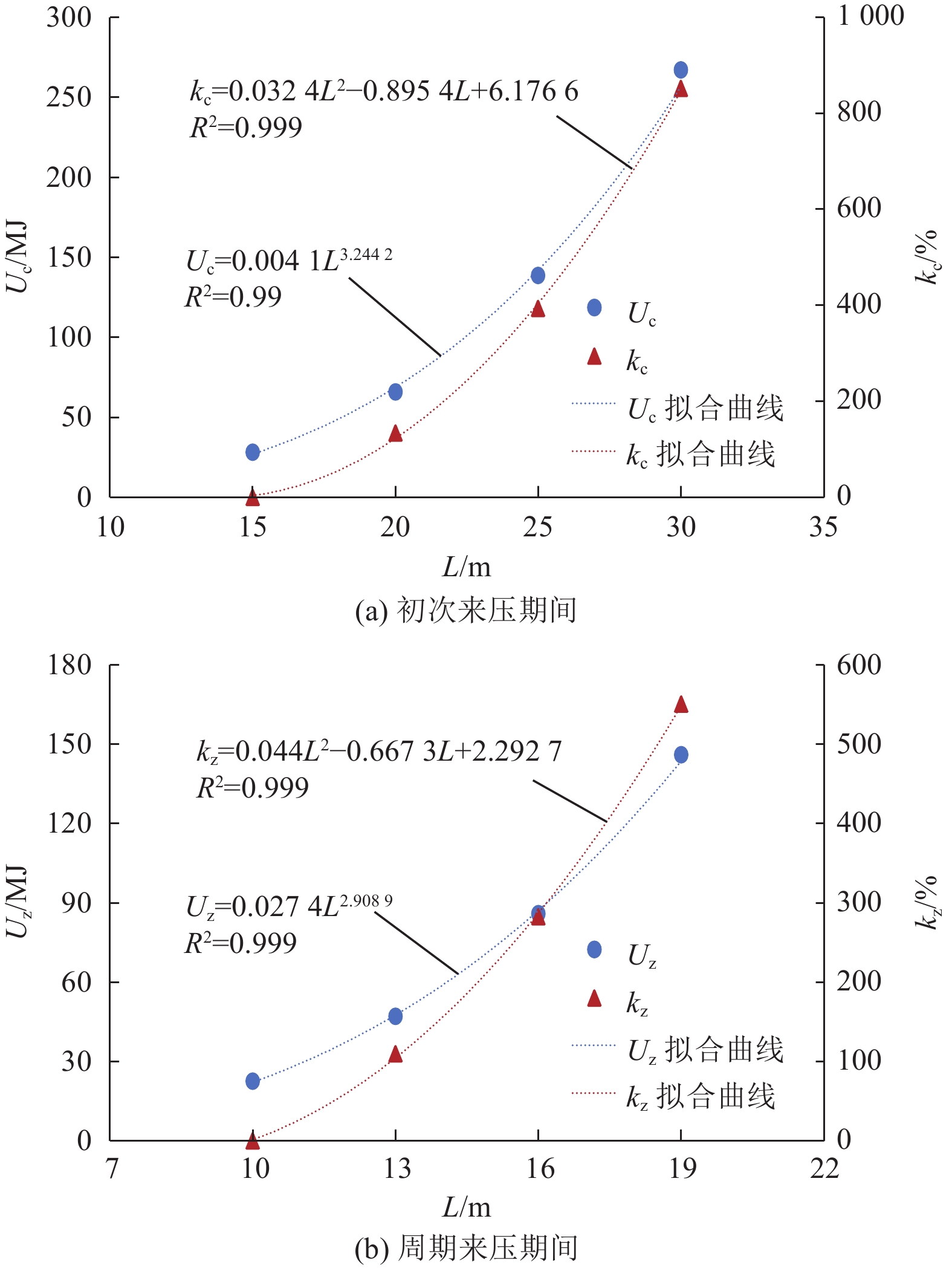Mechanisms and control of rock bursts in goaf-side roadways under the condition of thick and hard roofs in the Xinjie mining area, Inner Mongolia
-
摘要:目的和方法
针对厚硬顶板条件下深部矿井回采巷道冲击地压严重威胁工作面安全生产的问题,以内蒙古新街矿区典型深采矿井3-1103工作面辅运巷为工程研究背景,分析邻空巷道冲击地压频发区域外在主控因素和内在驱动力源;构建基于软化地基与弹性地基假定“岩梁−地基”系统力学特性的顶板断裂前受载力学模型,解析采场覆岩结构演化过程厚硬顶板岩梁能量演化规律及其主控因素;运用FLAC3D模拟并探查邻空巷道冲击失稳高风险区域位置与特征;研究采场覆岩结构优化与围岩应力能量控制方案,制定厚硬顶板破断诱发邻空巷道冲击地压控制方法。
结果和结论结果表明:(1) 邻空巷道冲击地压频发区域易发生以高静载或高静载叠加动载为主导灾变力源的失稳破坏,影响因素主要为顶板厚硬岩层、邻近采空区、区段煤柱。(2) 顶板储能总量与覆岩载荷、软化地基系数、顶板岩梁弹性模量及惯性矩、采空区顶板极限跨距、工作面支架参数等有关。其中,覆岩载荷、软化地基系数和采空区顶板极限跨距与岩梁应变能密度呈正相关,顶板岩梁弹性模量及惯性矩、工作面支护参数与岩梁应变能密度呈负相关。(3) 回采期间3-1103工作面超前支承压力区及其影响区域内区段煤柱和回采巷道煤体呈现多因素叠加影响,发生应力集中和能量积聚,是冲击失稳高风险区域;该区域较3-1101综采面其围岩应力与能量集中度进一步加剧增大。其中,工作面前方应力和应变能密度峰值增幅最大分别为6.61%、12.04%,区段煤柱应力和应变能密度峰值增幅最大分别为29.06%、65.14%。(4) 提出了“卸压爆破预处理高静载区域+深孔爆破或水力致裂预裂厚硬顶板+强化巷道吸能防冲支护”的解决方案,现场应用效果明显。
Abstract:Objective and MethodsRock bursts in mining roadways in deep coal mines under the condition of thick and hard roofs severely threaten the safe coal mining of the mining face. To meet this threat, this study, focusing on the No.3-1103 mining face auxiliary transport roadway, a goaf-side roadway, in a typical deep mine of the Xinjie mining area, Inner Mongolia, analyzed the external dominant factors and internal driving sources for frequent rock bursts in the goaf-side roadway. Assuming the mechanical characteristics of the rock beam-foundation system, this study constructed mechanical models under loading before roof fracturing based on soft and elastic foundations. Using these models, this study determined the evolutionary patterns of the rock beam energy in the thick and hard roof during the structural evolution of overburden in the stope, as well as their dominant factors. Based on FLAC3D simulation results, this study investigated the locations and characteristics of high-risk zones of rock burst-induced instability in the goaf-side roadway. Finally, this study developed a scheme for optimizing overburden structures and controlling the stress energy of surrounding rocks in the stope, along with a method for controlling rock bursts in the goaf-side roadway induced by the fracturing of the thick and hard roof.
Results and ConclusionsThe results indicate that zones with frequent rock bursts in the goaf-side roadway are susceptible to instability failures caused primarily by high static loads or high static loads with superimposed dynamic loads. The primary influencing factors of such failures include the thick and hard roof, the adjacent goaf, and section coal pillars. The total energy storage capacity of the roof is related to factors like overburden load, soft foundation coefficient, the elastic modulus and moment of inertia of rock beams in the roof, the limit span of the goaf roof, and the support parameters of the mining face. Specifically, the strain energy density of the rock beams is positively correlated with the overburden load, soft foundation coefficient, and limit span of the goaf roof but negatively correlated with the elastic modulus and moment of inertia of rock beams in the roof and the support parameters of the mining face. During the coal mining along the No.3-1103 mining face, section coal pillars and coals in the mining roadway within the advance support pressure zone and its influencing zones are affected by superimposed multiple factors, which lead to stress concentration and energy accumulation. Therefore, these zones face high risks of rock burst-induced instability. Compared to the No.3-1101 fully mechanized mining face, these zones exhibit significantly intensified surrounding rock stress and energy concentration. The peak values of stress and strain energy densities in front of the mining face increase by 6.61% and 12.04% at most, respectively. In contrast, the peak values of stress and strain energy densities of section coal pillars increase by 29.09% and 65.14% at most, respectively. Finally, this study developed a comprehensive scheme involving the blasting and pressure relief of high static load zones, the pre-fracturing of the thick and hard roof through deep-hole blasting or hydraulic fracturing, reinforcing energy-absorbing and anti-rock burst supports in the roadway, with significant effects having been achieved in the field application of this scheme.
-
-
表 1 不同长度顶板岩梁应变能值与增幅变化
Table 1 Strain energy values and their increased amplitude for rock beams under different roof lengths
初次来压 周期来压 顶板长度L/m 顶板岩梁应变能Uc/MJ 顶板岩梁应变能增幅kc/% 顶板长度L/m 顶板岩梁应变能Uz/MJ 顶板岩梁应变能增幅kz/% 15 28.064 10 22.452 20 65.670 134.00 13 47.036 109.49 25 138.485 393.46 16 85.823 282.25 30 267.031 851.50 19 145.940 550.01 -
[1] 窦林名,牟宗龙,曹安业,等. 煤矿冲击矿压防治[M]. 北京:科学出版社,2017. [2] 潘岳,王志强,李爱武. 初次断裂期间超前工作面坚硬顶板挠度、弯矩和能量变化的解析解[J]. 岩石力学与工程学报,2012,31(1):32−41. PAN Yue,WANG Zhiqiang,LI Aiwu. Analytic solutions of deflection,bending moment and energy change of tight roof of advanced working surface during initial fracturing[J]. Chinese Journal of Rock Mechanics and Engineering,2012,31(1):32−41.
[3] 潘岳,顾士坦. 周期性来压坚硬顶板裂纹萌生初始阶段的弯矩、剪力、挠度和应变能变化分析[J]. 岩石力学与工程学报,2014,33(6):1123−1134. PAN Yue,GU Shitan. Analysis of bending moment,shear force,deflection and strain energy of hard roof at initial stage of cracking during periodic pressures[J]. Chinese Journal of Rock Mechanics and Engineering,2014,33(6):1123−1134.
[4] 卜庆为,涂敏,张向阳,等. 采场厚硬顶板破断失稳与能量聚散演化研究[J]. 采矿与安全工程学报,2022,39(5):867−878. BU Qingwei,TU Min,ZHANG Xiangyang,et al. Study on fracture instability and energy accumulation-release evolution of thick-hard roof in stope[J]. Journal of Mining & Safety Engineering,2022,39(5):867−878.
[5] 李文龙,屠世浩,郝定溢,等. 推采速度和充实率对深井充填面厚硬顶板聚能与释能的影响[J]. 中国矿业大学学报,2021,50(3):498−506. LI Wenlong,TU Shihao,HAO Dingyi,et al. Influence of mining speed and filling ratio on energy accumulation and release of thick and hard roof in deep backfilling working face[J]. Journal of China University of Mining & Technology,2021,50(3):498−506.
[6] 冯龙飞,窦林名,王晓东,等. 回采速度对坚硬顶板运动释放能量的影响机制[J]. 煤炭学报,2019,44(11):3329−3339. FENG Longfei,DOU Linming,WANG Xiaodong,et al. Mechanism of mining advance speed on energy release from hard roof movement[J]. Journal of China Coal Society,2019,44(11):3329−3339.
[7] 王恩元,冯俊军,孔祥国,等. 坚硬顶板断裂震源模型及应力波远场震动效应[J]. 采矿与安全工程学报,2018,35(4):787−794. WANG Enyuan,FENG Junjun,KONG Xiangguo,et al. A hard roof fracture source model and its far-field seismic impact by stress wave[J]. Journal of Mining & Safety Engineering,2018,35(4):787−794.
[8] 高明仕,徐东,贺永亮,等. 厚硬顶板覆岩冲击矿震影响的远近场效应研究[J]. 采矿与安全工程学报,2022,39(2):215−226. GAO Mingshi,XU Dong,HE Yongliang,et al. Investigation on the near-far field effect of rock burst subject to the breakage of thick and hard overburden[J]. Journal of Mining & Safety Engineering,2022,39(2):215−226.
[9] 潘超. 高位坚硬顶板失稳诱发强矿压机理与控制[D]. 重庆:重庆大学,2020. PAN Chao. Mechanism and control of strong ground pressure induced by instability of high hard roof[D]. Chongqing:Chongqing University,2020.
[10] 窦礼同. 厚煤层坚硬顶板结构失稳诱发强矿压机制与防控技术[D]. 淮南:安徽理工大学,2021. DOU Litong. Mechanism and prevention technology of strong ground pressure induced by structural instability of hard roof in thick coal seam[D]. Huainan:Anhui University of Science & Technology,2021.
[11] 杨敬轩,刘长友,于斌,等. 坚硬顶板群下工作面强矿压显现机理与支护强度确定[J]. 北京科技大学学报,2014,36(5):576−583. YANG Jingxuan,LIU Changyou,YU Bin,et al. Strong strata pressure caused by hard roof group structure breaking and supporting strength determination[J]. Journal of University of Science and Technology Beijing,2014,36(5):576−583.
[12] 高明仕,徐东,王海川,等. 特厚煤层巷道冲击破坏机理及全锚索支护技术[J]. 煤炭学报,2023,48(5):1943−1956. GAO Mingshi,XU Dong,WANG Haichuan,et al. Shock failure mechanism of roadway in extra thick coal seam and full anchor cable support technology[J]. Journal of China Coal Society,2023,48(5):1943−1956.
[13] 韩军,崔露郁,贾冬旭,等. 坚硬顶板回采巷道冲击地压的卸载滑脱机制[J]. 煤炭学报,2022,47(2):711−721. HAN Jun,CUI Luyu,JIA Dongxu,et al. Unloading-slippage mechanism of rock burst occurred in longwall roadway[J]. Journal of China Coal Society,2022,47(2):711−721.
[14] 解嘉豪,韩刚,孙凯,等. 邻空巷坚硬顶板预裂爆破防冲机理及效果检验[J]. 煤炭学报,2023,48(5):2078−2091. XIE Jiahao,HAN Gang,SUN Kai,et al. Rockburst prevention mechanism and effect test of blast presplitting of hard roof in gob-side roadway[J]. Journal of China Coal Society,2023,48(5):2078−2091.
[15] 赵毅鑫,周金龙,刘文岗. 新街矿区深部开采邻空巷道受载特征及冲击失稳规律分析[J]. 煤炭学报,2020,45(5):1595−1606. ZHAO Yixin,ZHOU Jinlong,LIU Wengang. Characteristics of ground pressure and mechanism of coal burst in the gob side roadway at Xinjie deep mining area[J]. Journal of China Coal Society,2020,45(5):1595−1606.
[16] 刘国磊,王泽东,崔嵛,等. 深部煤巷围岩三向应力差异梯度致冲机理[J]. 煤炭学报,2023,48(5):2106−2122. LIU Guolei,WANG Zedong,CUI Yu,et al. Mechanism of rock burst in deep coal tunnel surroundings due to three-way stress difference gradient[J]. Journal of China Coal Society,2023,48(5):2106−2122.
[17] 于斌,高瑞,孟祥斌,等. 大空间远近场结构失稳矿压作用与控制技术[J]. 岩石力学与工程学报,2018,37(5):1134−1145. YU Bin,GAO Rui,MENG Xiangbin,et al. Near-far strata structure instability and associate strata behaviors in large space and corresponding control technology[J]. Chinese Journal of Rock Mechanics and Engineering,2018,37(5):1134−1145.
[18] 于斌,邰阳,匡铁军,等. 大空间采场远近场坚硬顶板井上下控制理论及技术体系[J]. 煤炭学报,2023,48(5):1875−1893. YU Bin,TAI Yang,KUANG Tiejun,et al. Theory and technical system of control of far-near field hard roofs from ground and underground in a large space stope[J]. Journal of China Coal Society,2023,48(5):1875−1893.
[19] 潘俊锋,马文涛,刘少虹,等. 坚硬顶板水射流预制缝槽定向预裂防冲技术试验[J]. 岩石力学与工程学报,2021,40(8):1591−1602. PAN Junfeng,MA Wentao,LIU Shaohong,et al. A prevention technology of rock burst based on directional presplitting of water jet prefabricated slot in hard roof[J]. Chinese Journal of Rock Mechanics and Engineering,2021,40(8):1591−1602.
[20] 窦林名,阚吉亮,李许伟,等. 断顶爆破防治冲击矿压技术体系及效果评价研究[J]. 煤炭科学技术,2020,48(1):24−32. DOU Linming,KAN Jiliang,LI Xuwei,et al. Study on prevention technology of rock burst by break-tip blasting and its effect estimation[J]. Coal Science and Technology,2020,48(1):24−32.
[21] 何满潮,高玉兵,杨军,等. 厚煤层快速回采切顶卸压无煤柱自成巷工程试验[J]. 岩土力学,2018,39(1):254−264. HE Manchao,GAO Yubing,YANG Jun,et al. Engineering experimentation of gob-side entry retaining formed by roof cutting and pressure release in a thick-seam fast-extracted mining face[J]. Rock and Soil Mechanics,2018,39(1):254−264.
[22] 高明仕,贺永亮,徐东,等. 冲击地压巷道减隔震技术原理及应用[J]. 煤炭科学技术,2021,49(6):53−60. GAO Mingshi,HE Yongliang,XU Dong,et al. Principle and application of reduce and isolation technology in rock burst roadway[J]. Coal Science and Technology,2021,49(6):53−60.
[23] 高明仕,窦林名,张农,等. 冲击矿压巷道围岩控制的强弱强力学模型及其应用分析[J]. 岩土力学,2008,29(2):359−364. GAO Mingshi,DOU Linming,ZHANG Nong,et al. Strong-soft-strong mechanical model for controlling roadway surrounding rock subjected to rock burst and its application[J]. Rock and Soil Mechanics,2008,29(2):359−364.
[24] 翁明月,郝英豪,解嘉豪. 坚硬煤岩体“钻−切−压” 一体化释能减冲技术研究[J]. 煤炭科学技术,2019,47(8):84−88. WENG Mingyue,HAO Yinghao,XIE Jiahao. Study on “drilling-cutting-fracturing” integrated energy dissipation technology for hard coal rock mass[J]. Coal Science and Technology,2019,47(8):84−88.
[25] 潘一山,齐庆新,王爱文,等. 煤矿冲击地压巷道三级支护理论与技术[J]. 煤炭学报,2020,45(5):1585−1594. PAN Yishan,QI Qingxin,WANG Aiwen,et al. Theory and technology of three levels support in bump-prone roadway[J]. Journal of China Coal Society,2020,45(5):1585−1594.
[26] 王爱文,潘一山,齐庆新,等. 煤矿冲击地压巷道三级吸能支护的强度计算方法[J]. 煤炭学报,2020,45(9):3087−3095. WANG Aiwen,PAN Yishan,QI Qingxin,et al. Strength calculation method of three-level energy absorption support in rockburst roadways for coal mines[J]. Journal of China Coal Society,2020,45(9):3087−3095.
[27] 徐连满,潘威翰,潘一山,等. O型棚支护抵抗冲击地压等级计算方法[J]. 煤炭学报,2020,45(10):3408−3417. XU Lianman,PAN Weihan,PAN Yishan,et al. Calculation method of rock burst resistance grade of O-shaped shed support[J]. Journal of China Coal Society,2020,45(10):3408−3417.
[28] 曾接兵. 红庆河煤矿双煤柱开采冲击危险特征及其主动调控[D]. 徐州:中国矿业大学,2022. ZENG Jiebing. Burst hazard characteristics of double-panel-pillar mining and its active control in Hong-Qing-He Coal Mine[D]. Xuzhou:China University of Mining and Technology,2022.
[29] 吕国伟. 红庆河煤矿多层厚弱顶板复合诱冲效应[D]. 徐州:中国矿业大学, 2020. LYU Guowei. Induced rockburst effect of the composite of multi-layer thick and weak roof in Hongqinghe Coal Mine[D]. Xuzhou:China University of Mining and Technology,2020.
[30] 杨志良. 神东矿区高应力软岩巷道底臌机理及其控制技术研究[D]. 北京:中国矿业大学(北京),2023. YANG Zhiliang. Research on mechanism and control technology of floor heave for high stress soft roadway in Shendong mining area[D]. Beijing:China University of Mining and Technology (Beijing),2023.
[31] 刘晨康. 红庆河煤矿动压巷道聚能爆破切顶卸压技术研究[D]. 北京:中国矿业大学(北京), 2019. LIU Chenkang. Research on energy-driven blasting cutting-top and depressurization technology for Hongqinghe Coal Mine[D]. Beijing:China University of Mining and Technology (Beijing),2019.
[32] 龙驭球. 弹性地基梁的计算[M]. 北京:人民教育出版社,1981. [33] 刘文超,赵毅鑫. 红庆河矿典型工作面冲击地压灾变机理及防治[J]. 矿业科学学报,2023,8(6):803−816. LIU Wenchao,ZHAO Yixin. Mechanism and prevention of typical coal burst disaster at the working face of Hongqinghe coal mine[J]. Journal of Mining Science and Technology,2023,8(6):803−816.
[34] 钱鸣高,石平五,许家林. 矿山压力与岩层控制[M]. 2版. 徐州:中国矿业大学出版社,2010.








 下载:
下载:











